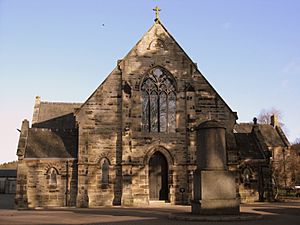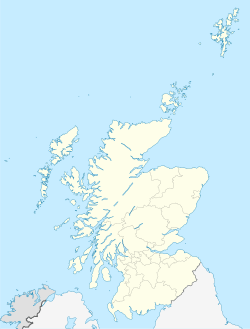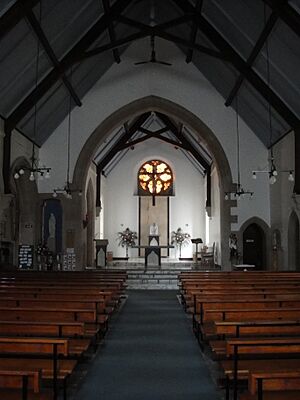St Michael's Roman Catholic Church, Linlithgow facts for kids
Quick facts for kids St Michael's Roman Catholic Church, Linlithgow, Scotland. |
|
|---|---|
 |
|
| 55°58′43″N 3°35′41″W / 55.97861°N 3.59472°W | |
| Location | Linlithgow |
| Country | Scotland |
| Denomination | Roman Catholic |
| History | |
| Status | Parish church |
| Founded | 1850 |
| Dedicated | 1893 |
| Architecture | |
| Architect(s) | Peter Paul Pugin |
| Style | Gothic Revival style |
| Completed | 1893 |
| Administration | |
| Parish | St. Michael's |
| Deanery | Linlithgow |
| Archdiocese | Archdiocese of St Andrews and Edinburgh |
St Michael's Roman Catholic Church is in the old town of Linlithgow, Scotland. It sits at the east end of town, near Linlithgow Loch. It is also close to the historic Linlithgow Palace, where Mary, Queen of Scots was born. Next to the palace is the Parish Church of St Michael's, which was the original Catholic church before the Scottish Reformation. This article tells the story of the Catholic Church in Linlithgow from its beginnings to today.
Contents
History of the Church
Early Days of Catholicism in Linlithgow
Linlithgow has a long connection with the Catholic faith in Scotland. The current St Michael's Church has been by Linlithgow Loch for over a century. However, the name St Michael has been linked to Linlithgow since the 1200s.
The original St Michael's Parish Church is in the town centre, next to Linlithgow Palace. This church had strong ties to the Scottish kings and queens, including Mary Queen of Scots. She was born in Linlithgow Palace in late 1542 and was baptised in St Michael's Church.
Records from 1138 show that St Michael's Church was already large and important. It was known as a "mother church" even before it was officially dedicated in 1242. This old church, located near the palace, shows how powerful the Roman Catholic Church was before the Reformation.
The Reformation and Changes
By the 1500s, many people wanted to change the Church. Some wanted small changes to fix problems, while others wanted big changes. In 1561, Catholic worship at St Michael's ended. The Catholic priest, Patrick Frenche, was replaced by a Protestant minister. It is believed that Patrick Frenche and other Catholics had to leave the country.
After the Scottish Reformation, it was against the law to say or hear Catholic Mass in Scotland. So, there are not many records of how Catholics worshipped in Linlithgow during this time. We know that travelling priests visited the town. However, not much is recorded until much later. This was when many Irish families arrived, and there was a clear need for Catholic religious care in Linlithgow.
Around the mid-1800s, many Irish Catholics came to Scotland because of the famine in Ireland. Many worked on farms around Linlithgow. Later, the shale oil industry grew in West Lothian. This led to a permanent Catholic community in the town.
Building the Current Church
The current St Michael's Church was designed by Peter Paul Pugin. He was a famous architect from the Victorian era. The church is built in the Gothic Revival style. It was officially dedicated in 1893. However, the Catholic community was so eager for a permanent church that the first Mass was held in the partly finished building on Valentine's Day in 1888.
In the late 1800s, many Irish workers came to Linlithgow for jobs in the growing oil shale industry. They wanted a permanent place to worship. They asked the Archdiocese of St Andrews and Edinburgh for help. As a result, the first resident Catholic priest in about 300 years was appointed. Father Andrew Smith quickly helped them. He got permission for Mass to be held on Sundays at Spence's Tannery. Soon, they found a better place, the Baird Hall. But the new church members still wanted their own building.
Building a new church was very expensive. The community had little money, but they worked hard to save up. Their prayers were answered when Father John M. Murphy was appointed. He had trained as a stonemason before becoming a priest. He understood his parishioners' needs. He announced a big bazaar to raise money for a new church. He wanted to dedicate it to Mary Queen of Scots.
Less than a year after he arrived, Father Murphy started building the church himself. Young men from the parish helped him. The Archbishop laid the foundation stone in 1887. On that day, the parish name was changed from St Joseph's to St Michael's. The church was dedicated to St Michael, but still in memory of Mary Queen of Scots. It was the only church in Scotland dedicated this way.
A few months later, the building officially opened. The unfinished parts were left bricked up until more money was available. The community then decided to build a school next to the church. St Joseph's school opened on July 1, 1889. It later moved to Preston Road in 1964.
Father Easson took over as parish priest after Father Murphy. The church building continued to grow. Plans were made to double the church's size. In June 1894, the Archbishop celebrated a special Mass there.
The 1900s and Beyond
St Michael's continued to grow in the early 1900s. This was despite tough times like World War I and the Great Depression. These events affected many families in the Linlithgow area. The demand for shale oil dropped during the Depression, and many families had little or no income.
In 1938, the parish celebrated 50 years since the church's foundation stone was laid. Soon after, World War II began, and many men joined the armed forces. In 1946, the church celebrated the blessing of its main altar.
In 1940, Father Michael McGovern became the parish priest. He worked tirelessly for the parish for 40 years. He helped create the tennis courts and the Queen Margaret Hall. Another important project was the Laetare International Youth Centre, which he opened in 1942. During the war, this centre housed Polish soldiers. They built a shrine to the Blessed Virgin in the church grounds, which is still there today.
The church community kept growing in the later 1900s. Linlithgow became a popular town for people working in Glasgow and Edinburgh. New industries also developed around West Lothian. In the late 1900s, priests like Canon Hugh Gordon and Father James Ferrari served the parish. Father Ferrari was the priest when the church celebrated its 100th anniversary. After he retired, Father Pat Boylan became priest, followed by Father Paul Kelly in June 2009.
Catholic Education
As Catholic services grew in Linlithgow, there was also a need for Catholic education for children. At first, the Sisters of Mercy taught the children. In the 1800s, the parish was dedicated to St Joseph, so the school was named St Joseph's. It still has that name today.
Classes were first held in the Baird Hall. Catholic students from nearby villages came to Linlithgow, many walking each day. In the 1880s, professional teachers took over. At first, two teachers taught 150 students. The first St Joseph's school building was finished in 1892. It was located on the church grounds.
Providing education was sometimes hard because children often had to work on farms. Health problems in the town also caused issues. The school sometimes had to close temporarily due to infectious diseases.
Before the end of World War I, St Joseph's, like other Catholic schools, was not part of the government school system. This changed with the Education Act of 1918. The school continued to do well throughout the early 1900s.
By 1949, the school had so many students that there wasn't enough room. Some classes were held in different buildings around town. At this time, the school taught both primary and junior secondary students. The students who were more advanced went to St Mary's in Bathgate. In 1955, the Junior Secondary School moved to a new building in Bo'ness. However, this did not solve all the space problems. So, the authorities agreed to build a new St Joseph's Primary School. In 1963, the current St Joseph's on Preston Road opened. With some improvements in the 1990s, it is still a thriving school today.
In the late 1970s, the link with Bo'ness for junior secondary education ended. All secondary students then went to St Mary's Bathgate. In the mid-1990s, St Mary's closed to make way for a new secondary school in Livingston. Linlithgow students then started going to St Kentigern's Blackburn.
Today, teachers at both St Joseph's and St Kentigern's work closely with the local priest and parents. Together, they provide a strong Catholic education for the children of the parish.
See also
- St Michael's Parish Church, Linlithgow, a burgh church in the Church of Scotland



